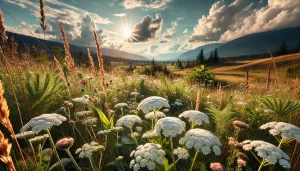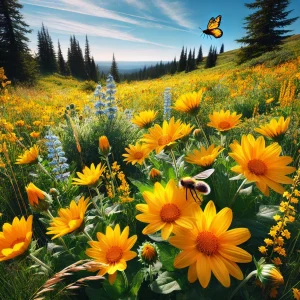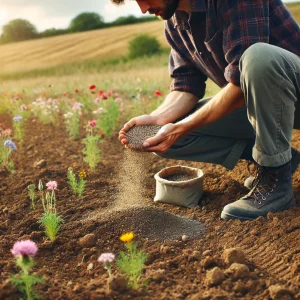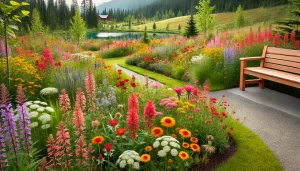Wildflower meadows are a fantastic way to create vibrant and diverse landscapes while supporting local wildlife. These beautiful, low-maintenance ecosystems can transform any garden into a haven of colour and life. For homeowners and landscapers in British Columbia, wildflower meadows offer a unique opportunity to embrace natural beauty and sustainability. This blog will explore the benefits of wildflower meadows, provide practical tips for starting and maintaining one, and highlight some specific wildflowers native to British Columbia.

Benefits of Wildflower Meadows
- Low Maintenance: One of the most significant advantages of wildflower meadows is their low maintenance requirements. Unlike traditional lawns, which demand regular mowing, fertilizing, and watering, wildflower meadows thrive with minimal intervention. Once established, they require little more than seasonal mowing to keep invasive species at bay.
- Habitat for Wildlife: Wildflower meadows provide essential habitats for wildlife, including pollinators like bees and butterflies, birds, and small mammals. These meadows support biodiversity by offering food sources and nesting sites, contributing to healthier ecosystems.
- Aesthetic Appeal: Wildflower meadows are undeniably beautiful. They create a stunning tapestry of colours and textures that change with the seasons, providing year-round visual interest. This dynamic landscape can enhance the aesthetic appeal of any property.

Starting a Wildflower Meadow
- Choose the Right Site: Select an area with plenty of sunlight and well-drained soil. Wildflowers generally prefer poor soil conditions, so there’s no need for extensive soil preparation.
- Select Native Wildflowers: Native wildflowers are crucial for a flourishing meadow. In British Columbia, some excellent options include:
- Common Red Paintbrush (Castilleja miniata): This bright red flower is a favourite among pollinators.
- Yarrow (Achillea millefolium): Known for its white, flat-topped clusters, yarrow is hardy and drought-resistant.
- Oregon Sunshine (Eriophyllum lanatum): With its cheerful yellow blooms, this flower adds a pop of colour and attracts various insects.
- Prepare the Soil: Remove existing vegetation and lightly till the soil to create a hospitable environment for your seeds. Avoid using fertilizers, as wildflowers thrive in nutrient-poor soils.
- Sow the Seeds: Mix your wildflower seeds with sand to ensure even distribution, then broadcast them over the prepared soil. Lightly rake the area to cover the seeds, but avoid burying them too deeply.
- Watering: After planting, water the area gently but thoroughly. Continue to water occasionally during dry spells until the seedlings are established.

Seasonal Considerations
The best time to sow wildflower seeds in British Columbia is in the fall or early spring. Fall planting allows seeds to undergo natural stratification, promoting better germination rates. Spring planting is also effective but may require more consistent watering.

Maintenance Tips
- Annual Mowing: Mow your wildflower meadow yearly, ideally in late fall or early spring. This practice helps control invasive species and encourages the growth of perennials.
- Weed Control: During the first year, monitor your meadow for invasive weeds and remove them promptly to give your wildflowers a competitive edge.
- Natural Mulching: Leave the mowed clippings on the ground as a natural mulch. This helps retain soil moisture and adds organic matter back to the soil.

Costs and Considerations
Creating and maintaining a wildflower meadow is generally cost-effective. Initial costs include seed purchase and minimal soil preparation. Long-term savings come from reduced water usage, fertilizer, and mowing costs. However, patience is essential; wildflower meadows can take a few years to reach their full potential.
Common Misconceptions
- Wildflower Meadows Look Untidy: While wildflower meadows have a natural, unmanicured appearance, they can be designed to look intentional and beautiful. Edging the meadow with mowed paths or borders can create a neat and inviting look.
- Difficult to Establish: With proper planning and care, wildflower meadows are not difficult to establish. Selecting the right seeds and understanding your local climate are key to success.

Local Resources and Organizations
In British Columbia, several organizations support wildflower meadow initiatives. The Society for Ecological Restoration of British Columbia (SERBC) and local native plant societies offer resources and advice for creating and maintaining wildflower habitats.
Wildflower meadows are a beautiful and sustainable option for homeowners and landscapers in British Columbia. By following these guidelines and embracing the natural beauty of wildflowers, you can create a vibrant, low-maintenance landscape that supports local wildlife and enhances the aesthetic appeal of your property. Embrace wildflower meadows’ charm and ecological benefits and transform your garden into a thriving, colourful haven.